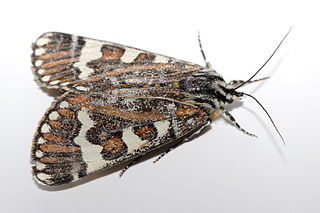
The pasture day moth, Apina callisto, is a species in the moth family Noctuidae which is active during the day, as its common name implies, making it unlike most other noctuid species. It is found in most southern areas of Australia, ranging from lower Queensland to Tasmania. The species was first described by George French Angas in 1847. It is the only species in the monotypic genus Apina, erected by Francis Walker in 1855.
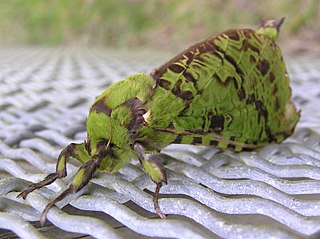
Aenetus is a genus of moths of the family Hepialidae. There are 24 described species found in Indonesia, New Guinea, New Caledonia, Australia and New Zealand. Most species have green or blue forewings and reddish hindwings, but some are predominantly brown or white. The larvae feed in the trunks of living trees, burrowing horizontally into the trunk, then vertically down.

The mistletoebird, also known as the mistletoe flowerpecker, is a species of flowerpecker native to most of Australia and also to the eastern Maluku Islands of Indonesia in the Arafura Sea between Australia and New Guinea. The mistletoebird eats mainly the berries of the parasitic mistletoe and is a vector for the spread of the mistletoe's seeds through its digestive system.
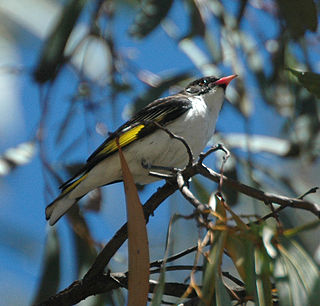
The painted honeyeater is a species of honeyeater in a monotypic genus.
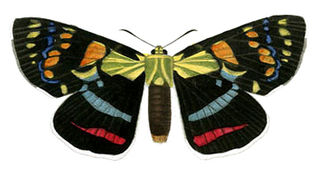
Agarista is a genus of moths in the family Noctuidae. The genus was erected by William Elford Leach in 1814..

Amyema miquelii, also known as box mistletoe, is a species of flowering plant, an epiphytic hemiparasitic plant of the family Loranthaceae, found attached to several species of Australian eucalypt and occasionally on some species of Acacia. It is the most widespread of the Australian Mistletoes, occurring mainly to the west of the Great Dividing Range. It has shiny leaves and red flowers arranged in groups of 3. It is distinguished from the similar Amyema pendula through the individual stalks of the flowers.

Angophora floribunda, commonly known as the rough-barked apple, is a common woodland and forest tree of the family Myrtaceae native to Eastern Australia. Reaching 30 m (100 ft) high, it is a large tree with fibrous bark and cream-white flowers that appear over the Austral summer. It grows on alluvial soils on floodplains and along watercourses. Much of the land it grew on has been cleared for agriculture.

Amyema quandang is a species of hemi-parasitic shrub which is widespread throughout the mainland of Australia, especially arid inland regions, sometimes referred to as the grey mistletoe.

Flindersia maculosa, commonly known as leopardwood or leopard tree, is a species of tree in the family Rutaceae and is endemic to inland areas of eastern Australia. It has mottled bark, simple leaves arranged in opposite pairs, white to cream-coloured flowers and fruit studded with rough points.
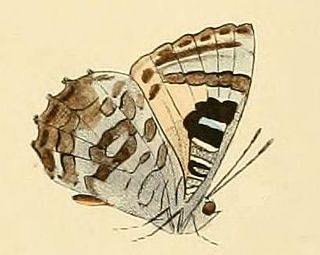
Ogyris oroetes, the silky azure, is a butterfly in the family Lycaenidae. It is found in most of mainland Australia.

Brachychiton gregorii, commonly known as the desert kurrajong, is a small tree of the genus Brachychiton found in northern and western Australia. It was originally classified in the family Sterculiaceae, which is now within Malvaceae.

Amyema congener, commonly known as the variable mistletoe, is a species of flowering plant, an epiphytic hemiparasitic plant of the family Loranthaceae from eastern Australia. It is found on members of the genera Allocasuarina, Acacia and some exotic species.

Ogyris amaryllis, the amaryllis azure or satin azure, is a butterfly in the family Lycaenidae. It is found in Australia.

Lysiana exocarpi, commonly known as harlequin mistletoe, is a species of hemiparasitic shrub, endemic to Australia. It is in the Gondwanan family Loranthaceae and is probably the most derived genus of that family with 12 pairs of chromosomes. The Loranthaceae is the most diverse family in the mistletoe group with over 900 species worldwide and including the best known species in Australia. Mistletoes are notable for their relationships with other species. In an early reference to the group in Australia Allan Cunningham explorer and first Director of the Royal Botanic Gardens, Sydney, wrote in 1817: "The Bastard Box is frequently much encumbered with the twining adhering Loranthus aurantiacus which 'Scorning the soil, aloft she springs, Shakes her red plumes and claps her golden wings'."
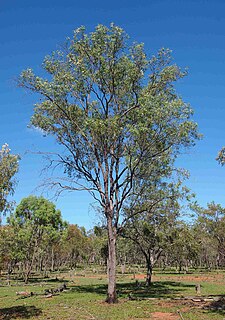
Eucalyptus exserta, commonly known as Queensland peppermint, peppermint, bendo, yellow messmate or messmate, is a species of tree or a mallee and is endemic to eastern Australia. It has hard, fibrous bark, lance-shaped adult leaves, flower buds in groups of seven, white flowers and hemispherical or cup-shaped fruit.

Muellerina eucalyptoides, or creeping mistletoe, is a hemiparasitic arial shrub in the family Loranthaceae. The species is endemic to Australia. M. eucalyptoides is pendulous in habit, unlike other Muellerina species, but has the long epicortical runners of all Muellerina species.

Amyema sanguinea is an arial hemiparasitic shrub within the genus Amyema, in the family Loranthaceae and native to Australia, where it is found in New South Wales, Queensland, the Northern Territory, South Australia and Western Australia.

Amyema melaleucae, also known as the tea-tree mistletoe, is a species of flowering plant within the genus Amyema, an epiphytic hemiparasitic plant of the family Loranthaceae native to Australia and found in Western Australia and South Australia on the coast, from north of Perth almost to the Victorian border.

Amyema cambagei, commonly known as sheoak mistletoe, is a species of flowering plant, an epiphytic hemiparasitic plant of the family Loranthaceae endemic to Australia, and found in New South Wales and Queensland in sclerophyll forest and woodland on several species of Casuarinaceae.
Amyema pliculata is a species of hemi-parasitic shrub found in the Bismarck Archipelago, New Guinea, New South Wales and Queensland.



















